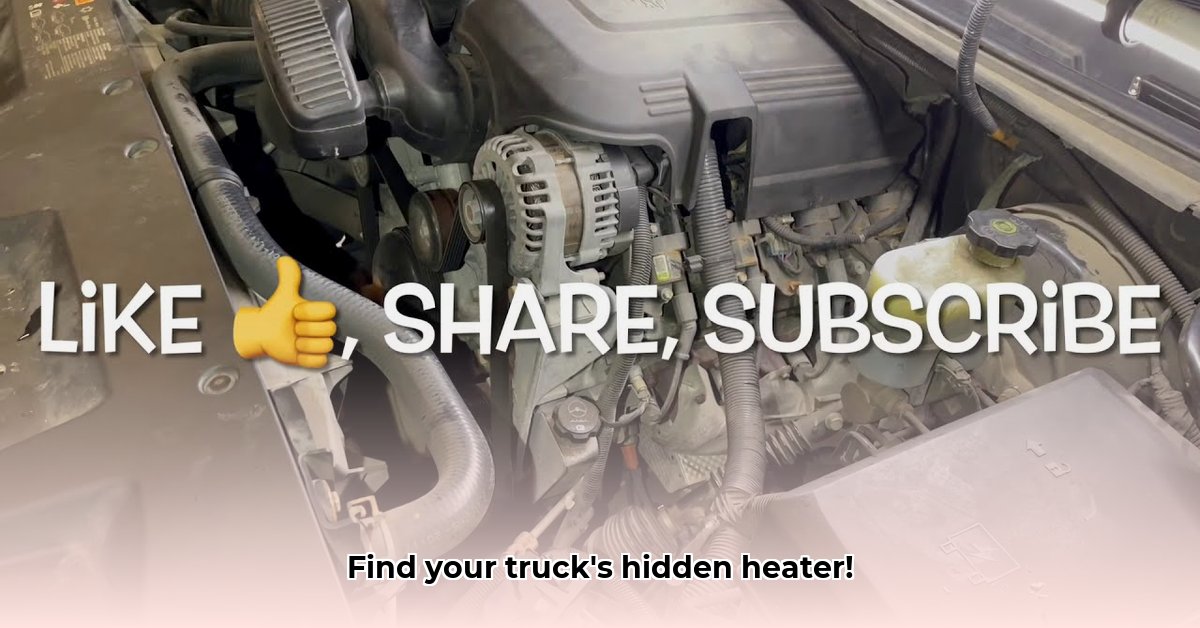
Cold weather can severely impact your trucking operations. Frozen engines lead to costly delays. This guide provides clear, step-by-step instructions on locating, connecting, and using your cab block heater, ensuring your rig stays operational even in freezing temperatures. We'll also troubleshoot common problems, maximizing uptime and minimizing downtime. For more information on truck heaters, check out this helpful resource: truck heater guide.
Locating Your Cab Block Heater
Finding your block heater may seem challenging, but it's simpler than you think. Your owner's manual is your primary resource; it provides specific locations for your truck model. Consult it first!
If you can't find your manual, follow these steps:
Visual Inspection: Carefully examine your engine compartment. Look for a thick, insulated cord leading from a metal fitting—this is your block heater. Common locations include near the oil pan or along the cylinder block. Remember, it's often hidden behind other components.
Trace the Cord: Gently follow the cord's path. It usually leads to an easily accessible plug or socket. Think of the cord as your guide.
Under the Cab: Many block heaters are situated under the driver's cab or chassis for protection from the elements. You might need to get down on your hands and knees for a thorough inspection.
Chassis Check: Don't overlook the truck frame. Some manufacturers position block heaters along the frame rails. A flashlight might be helpful in dimly lit areas.
Online Resources: If you're still having trouble after attempting the above, search online forums or your manufacturer's website for diagrams or location guides specific to your truck model.
Connecting Your Cab Block Heater Safely
Correctly connecting your block heater is crucial for both efficient operation and safety. Follow these steps:
Cord Inspection: Before plugging in, thoroughly inspect the cord for any damage (fraying, cracks, cuts). Replace a damaged cord immediately to prevent electrical hazards, including fire or electrical shock.
Dedicated Outlet: Always use a properly grounded outdoor rated extension cord and a dedicated outlet designed for the heater's current draw. Avoid overloading the circuit by plugging multiple high-draw appliances into the same outlet; this can trip breakers or cause a fire.
Extension Cord: If an extension cord is necessary, use a heavy-duty, weatherproof model rated for the heater's amperage. Avoid cheap, flimsy cords.
Timer (Optional): If your heater has a timer, set it appropriately. Preheating times vary based on temperature, wind chill, and engine size; we'll discuss this further below.
Optimizing Cab Block Heater Usage
Preheating time depends on several factors. Overheating is detrimental, reducing its lifespan.
Temperature: In moderately cold weather (above 20°F/-7°C), 1-2 hours of preheating may suffice. In freezing temperatures (below 0°F/-18°C), you'll likely need 3-6 hours, or even longer in extreme conditions.
Wind Chill: Wind significantly increases heat loss. In windy conditions, extend your preheating time or consider using an insulating cover to reduce heat loss.
Engine Size: Larger engines require longer preheating times. Consult your owner's manual for specific recommendations.
Insulation: Using an insulating cover around your engine and block heater can dramatically improve efficiency, requiring less overall heating time and saving energy.
Troubleshooting Common Problems
Even well-maintained heaters can experience issues. Here's a quick troubleshooting guide:
| Problem | Possible Cause(s) | Solution(s) |
|---|---|---|
| No Heat | Burned-out heating element, loose/corroded connections | Replace the element; check and tighten all connections. |
| Weak Heat | Low voltage, loose connections, failing element | Check voltage; tighten connections; replace the heater if needed. |
| Circuit Breaker Trips | Overloaded circuit, short circuit in wiring | Use a dedicated outlet; consult a qualified electrician. |
| Timer Malfunction | Defective timer | Replace the timer. |
Maintaining Your Cab Block Heater
Regular maintenance extends your block heater's lifespan:
Visual Inspection: Regularly inspect the cord and connections for any damage (wear, fraying, corrosion).
Cord Storage: When not in use, store the cord neatly to prevent damage. Avoid tight bends and kinks.
Professional Help: If you encounter problems you can't address, consult a qualified mechanic or electrician.
Safety Precautions
- Always disconnect the block heater before starting the engine. Failure to do so can damage the heater and create a fire hazard.
- Never work on electrical systems in wet conditions.
- If unsure about any aspect of installation or maintenance, seek professional assistance.
Remember, this guide offers general advice. Always consult your owner's manual for specific instructions tailored to your vehicle.